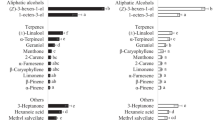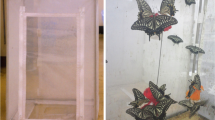Abstract
Electroantennograms (EAGs) were recorded from two predatory insect species, the twelve-spotted lady beetle, Coleomegilla maculata and the green lacewing, Chrysoperla carnea in response to semiochemicals emitted from one of their prey species, the pea aphid Acyrthosiphon pisum and their host plant. EAG responses were also recorded from C. maculata in response to extracts from individuals of the opposite sex and to extracts from an herbaceous plant, catnip Nepeta cataria. Extracts of catnip and two sex pheromone components of aphids, (4aS,7S,7aR)-nepetalactone and (1R,4aS,7S,7aR)-nepetalactol, elicited significant EAG responses from the antennae of both predatory species. Of 10 corn volatile compounds tested, C. carnea adults responded most strongly to 2-phenylethanol and (E)-β-farnesene. A significant difference in EAG response to extracts of corn leaf collections was observed between male and female C. carnea. In C. maculata, significant EAG responses were elicited by most of the tested corn volatile compounds, except α-pinene and (E)-2-hexenal. The highest EAG responses were observed in response to (E)-β-farnesene, α-terpineol, 2-phenylethanol, and β-caryophyllene. Sexual differences in EAG responses of C. maculata were only found in response to 1-octen-3-ol. Male antennae of C. maculata produced significant EAG responses to extracts from conspecific females, but not to males, which indicates that some chemicals from females could be involved in sexual communication. A significant EAG response also was recorded in response to the extracts of fluids produced during “reflex bleeding.” Male and female antennae of both species exhibited similar dose–response curves to most of the selected compounds, although female C. maculata antennae exhibited higher thresholds in response to several compounds including α-terpineol, (Z)-3-hexenol, and (4aS,7S,7aR)-nepetalactone. Field tests showed that 2-phenylethanol was highly attractive to both sexes of the two investigated species. Only C. maculata was attracted to traps baited with α-terpineol.
Similar content being viewed by others
REFERENCES
Barbier, R., Ferran, A., Le Lannic, J., and Allo, M.-R. 1992. Morphology and ultrastructure of integumentary glands of Semiadalia undecimnotata Schn. (Coleoptera: Coccinellidae). Int. J. Insect Morphol. Embryol. 21:223–234.
Bing, J. W., Guthrie, W. D., Dicke, F. F., and Obrycki, J. J. 1992. Seedling stage feeding by corn leaf aphid (Homoptera: Aphididae): Influence on plant development in maize. J. Econ. Entomol. 84:625–632.
Boo, K. S., Chung, I. B., Han, K. S., Pickett, J. A., and Wadhams, L. J. 1998. Response of the lacewing Chrysopa cognata Wesmael (Neuroptera: Chrysopidae) to pheromones of its aphid (Homoptera: Aphididae) prey. J. Chem. Ecol. 24:631–643.
Buttery, R. G., and Ling, L. C. 1984. Corn leaf volatiles: Identification using Tenax trapping for possible insect attractants. J. Agric. Food Chem. 32:1104–1106.
Canard, M., SÉmÉria, Y., and New, T. R. 1984. Biology of Chrysopidae. Dr. W. Junk, The Hague, 294 pp.
Colburn, R., and Asquith, D. 1970. A cage used to study the finding of a host by the ladybird beetle, Stethorus punctum. J. Econ. Entomol. 63:1376–1377.
Dawson, G. W., Janes, N. F., Mudd, A., Pickett, J. A., Slawin, A. M. Z., Wadhams, L. J., and Williams, D. J. 1989. The aphid sex pheromone. Pure Appl. Chem. 61:555–558.
Duelli, P. 1984. Flight, dispersal, migration, pp. 129–133, in M. Canard, Y. Semeria and T. R. New (eds.). Biology of Chrysopidae. W. Junk, The Hagu.
Eisenbraun, E. J., Browne, C. E., Irvin-Willis, R. L., McGruk, D. J., Eliel, E. L., and Harris, D. L. 1980. Structure and stereochemistry of 4aβ,7α,7aβ-nepetalactone from Nepta mussini and its relationship to the 4aα,7α,7aα-and 4aα,7α,7aβ-nepetalactone from N. cataria. J. Org. Chem. 45:3811–3814.
Evans, E. W., and Richards, D. R. 1997. Managing the dispersal of ladybrid beetles (Col: Coccinellidae): Use of artificial honeydew to manipulate spatial distributions. Entomophaga 42:93–102.
Flint, H. M., Slater, S. S., and Walters, S. 1979. Caryophyllene: An attractant for the green lacewing. Environ. Entomol. 8:1123–1125.
Frazier, B. D. 1988. Coccinellidae, pp. 231–247, in A. K. Minks and P. Harrewijn (eds.). Aphids-Their Biology. Natural Enemies and Control, Vol. B. New York, Elsevier, Amsterdam.
Gerling, D. 1990. Natural enemies of white flies: predators and parasitoids, pp. 147–185, in D. Gerling (ed.). Whiteflies: Their Bionomics, Pest Status and Management. Intercept Ltd., Andover.
Giles, K. L., Obrycki, J. J., and Degooyer, T. A. 1994. Prevalence of predators associated with Acyrthosiphon pisum (Homoptera: Aphididae) and Hypera postica Gyllenhal (Coleoptera: Curculionidae) during growth of the first crop of alfalfa. Biol. Cont. 4:170–177.
Hagen, K. S. 1987. Nutritional ecology of terrestrial insect predators, pp. 533–577, in F. Slansky and J. G. Rodriguez (eds.). Nutritional Ecology of Insects, Mites, Spiders, and Related Invertebrates. Wiley & Sons, New York.
Hardie, J., Hick, A. J., HÖller, C., Mann, J., and Merritt, L. 1994. The responses of Paron spp. parasitoids to aphid sex pheromone components in the field. Entomol. Exp. Appl. 71:95–99.
Jourdan, H., Barbier, R., Bernard, J., and Ferran, A. 1995. Antennal sensilla and sexual dimorphism of the adult lady beetle Semiadalia undecimnotata Schn. (Coleoptera: Coccinellidae). Int. J. Insect Morphol. Embryol. 24:307–322.
Nakamuta, K. 1991. Aphid alarm pheromone component, (E)-β-farnesene, and local search by a predatory lady beetle, Coccinella septempunctata bruckii Mulsant (Coleoptera: Coccinellidae). Appl. Entomol. Zool. 26:1–7.
Nault, L. R., Edwards, L. J., and Styer, W. E. 1973. Aphid alarm pheromones: Secretion and reception. Environ. Entomol. 2:101–105.
New, T. R. 1975. The biology of Chrysopidae and Hemerobiidae (Neuroptera) with reference to their usage as biocontrol agents: a review. Trans. R. Entomol. Soc. London 127:115–140.
Obata, S. 1987. Mechanisms of prey finding in the aphidophagous ladybird beetle, Harmonia axyridis (Coleoptera: Coccinellidae). Entomophaga 31:303–311.
Obrycki, J. J., and Kring, T. J. 1998. Predaceous coccinellidae in biological control. Annu. Rev. Entomol. 43:295–321.
Pettersson, J. 1970. An aphid sex attractant I. Biological studies. Entomol. Scand. 1:63–73.
Phoofolo, M. W. 1997. Evaluation of natural enemies of the European corn borer, Ostrinia nubilalis (Lepidoptera: Pyralidae). PhD thesis. Iowa State University, Ames, 172 pp.
Sparks, A. N., Chiang, H. C., Burkhardt, C. C., Fairchild, M. L., and Weekman, G. T. 1966. Evaluation of the influence of predation on corn borer populations. J. Econ. Entomol. 59:104–107.
Turlings, T. C. J., Wackers, F. L., Vet, L. E. M., Lewis, W. J., and Tumlinson, J. H. 1992. Learning of host-finding cues by hymenopterous parasitoids, pp. 51–78, in A. C. Lewis and D. R. Papaj (eds.). Insect Learning: Ecological and Evolutionary Perspectives. Chapman and Hall, New York.
Udayagiri, S. 1996. Behavioral manipulation of natural enemies: Potential use in insect pest management. Agric. Zool. Rev. 7:181–216.
van Emden, H. F., and Hagen, K. S. 1976. Olfactory reactions of the green lacewing, Chrysopa carnea, to tryptophan and certain breakdown products. Environ. Entomol. 5:469–473.
Author information
Authors and Affiliations
Rights and permissions
About this article
Cite this article
Zhu, J., Cossé, A.A., Obrycki, J.J. et al. Olfactory Reactions of the Twelve-Spotted Lady Beetle, Coleomegilla maculata and the Green Lacewing, Chrysoperla carnea to Semiochemicals Released from Their Prey and Host Plant: Electroantennogram and Behavioral Responses. J Chem Ecol 25, 1163–1177 (1999). https://doi.org/10.1023/A:1020846212465
Issue Date:
DOI: https://doi.org/10.1023/A:1020846212465




